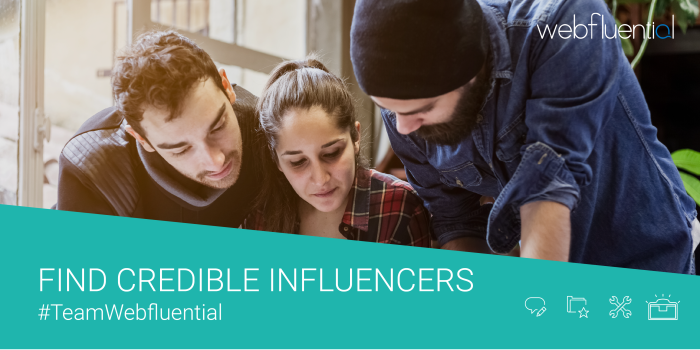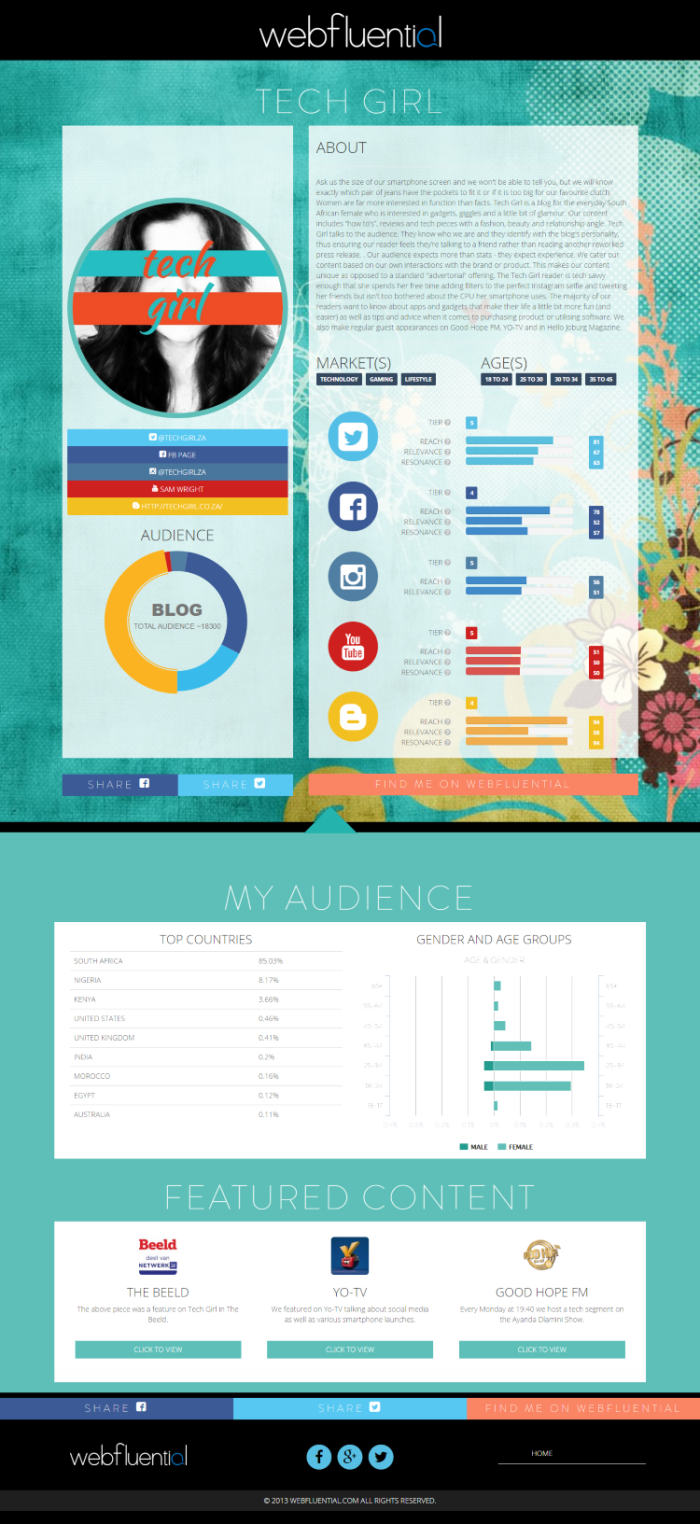December 9, 2015 3:25 pm
Published by Kirsty Sharman

Finding credible Influencers causes sleepless nights for many marketers. As innovators in the influencer economy, we feel it is our responsibility to make this as simple and effective as possible (so you can rest easy). Just as Airbnb has revolutionised the travel industry by providing a marketplace for accommodation owners to rent to travellers, we are transforming the marketing industry by offering a marketplace for influencers to sell their services to brands.
Our goal is to make Influencer Marketing easier than ever before.
This means we strive to make the search for credible influencers plain sailing for marketers and provide more opportunities for brands and Influencers to work together.
We recently added new Influencer tools to our platform that not only help Influencers market themselves better to brands, but also help brands select more relevant Influencers.
I have chosen the 2 new Influencer features that I think marketers will love:
1. New ways to partner with Influencers
If you have run an Influencer Marketing campaign on our platform in the past, you already know that we provide the best Influencer Marketing tools to search for influencers, manage campaigns and track results. However, as Influencer Marketing evolves, so do the needs of the community using our platform and this gives us the chance to add new features to move the industry forward.
In addition to being able to work with Influencers on Influencer Marketing campaigns, we have built-in new channels for brands and Influencers to partner on. These include:
- Event appearance: contract for half or full day to attend events
- Content writing: writing in exchange for a fee
- Display media: banner advertising on a blog
- Audience remarketing: remarketing to an audience that visits a particular blog

2. Compare Influencer media kits to make the best selection
Media kits are a standard tool used in the industry for Influencers to showcase their audience analytics, brands they have worked with and examples of content they have created. As marketers, we use these media kits to help evaluate the relevance of an Influencer for our brand. However, media kits are often outdated and difficult to compare as there is no standardised format.
Our new media kit tool allows Influencers to customise a template and give marketers access to their updated analytics, previous brand partnerships and created content. The format provides a more standardised layout to benchmark one Influencer against another, as well as, Webfluential verified analytics.

Finding credible Influencers does not have to be difficult. Sign up to our platform to see just how easy it can be.

Or find out more about these new features from our team?

Share this article
 December 2, 2015 2:21 pm
Published by Kirsty Sharman
December 2, 2015 2:21 pm
Published by Kirsty Sharman
Monetising your blog or social profiles and marketing yourself to brands are challenges many Influencers face. From novice to professionals, discovering new ways to make money or build brand partnerships, can be stumbling blocks that many struggle to resolve.
Webfluential launches new tools to help monetize your blog and market yourself to brands
Webfluential has always offered a quick and easy solution to gain exposure to big brands looking for Influencers. Our platform has created the perfect space for Influencers to market their blog, Twitter, Facebook, Instagram and YouTube to brands, by simply completing your Webfluential profile.
Now we are taking things a step further. We are launching some new tools today that will help all Webfluential Influencers monetise their online influence, be it via their blog, their Twitter profile, their Facebook page, YouTube account and beyond. Putting you one step closer to turning your blog into a business.
Market yourself to brands
Build your media kit easily
Most online Influencers realise the value of a media kit, as it is often the first thing a brand will ask for when they consider working with Influencers. A media kit displays important data like your website traffic, the size of your audience on various social media profiles and audience demographics.

Although we understand the importance of a media kit – we also know it takes a long time to create and update. We have solved this by launching a customisable media kit tool that is so easy to use. If you can attach a file to an e-mail – you will be able to build your media kit with the Webfluential platform.
The Webfluential media kit tool will give you one consolidated location where you can showcase your social channel data, blog traffic data, audience location and other demographics and is also a space to showcase past work you have completed with brands.
Become Webfluential accredited
We manually approve each of our Influencer applications. Being part of #TeamWebfluential shows that you take creating content and your audience seriously. You are a professional that works with brands and it’s important that you can show your credibility as a Webfluential Influencer.

We’ve created a collection of assets (badges) that you can use on your blog to identify yourself as a Webfluential Influencer to potential brands visiting your blog. To get these assets simply login to your Webfluential account and download them from your “Influencer Toolkit”.
We are also working on a customizable widget that you will be able to embed on your site to show that you are a Webfluential Influencer, that we will be releasing in the near future.
Invite and earn
We know that nobody understands Influencers as well as other Influencers (it’s why we have a team of Influencers working for us). It is also how we know that Influencers connect with each other and establish their own Influencer networks to learn and help each other.
Our “Invite and Earn” program is built for current Webfluential Influencers to invite other Influencers to sign up to Webfluential. Best part is that you will earn a referral fee for each new Influencer you introduce to Webfluential that successfully signs up.

The referral fee ranges between $10 and $50 for each new Influencer that signs up to Webfluential successfully, depending on their tier. Login to your Webfluential account and head to the “Invite and Earn” page to get your unique URL, and start earning money for introducing your Influencer friends to Webfluential.
The best of all, Webfluential is an international platform, so your friends can sign up no matter where in the world they are.
Add new channels to earn
Most of you have been privy to our beta launch of our new Influencer Earning Channels already. We know the work that is involved in building and maintaining an online audience, and as such we want to offer you as many ways to earn money from your work as possible.

Let’s take a look at the four new channels we have added in more detail:
Event Appearance
Taking time out of your day isn’t always the only price you pay to attend an event. That is why we have now added the ability to charge for event attendance from your Webfluential account.
You can contract for a half-day event or a full day event. Simply login to your Webfluential account and set your event attendance prices from your Profile Dashboard.
Copywriting
Writing is a skill that many Influencers have developed, so we have provided the platform for you to leverage this skill and make money.
You can set a price per word, price per revert and also set a minimum amount of days that it would take your to write a piece of content. Simply login to your Webfluential account and set your copywriting price from you Profile Dashboard.
Banner Advertising
Having banner advertising space on your site is one thing, managing the advertising space on your blog is another thing altogether. That is why you can now manage your banner advertising space from your Webfluential account.
Simply add the banner space that you have available on your blog and Webfluential will do the rest.
Audience Remarketing
With Audience Remarketing brands can use your blog to display certain banners to clients that are being targeted with ads.
All you have to do to enable Audience Remarketing on your blog is login to your Webfluential Account and apply via the Profile Dashboard.
We need your help
We are really happy that we can help Influencers turn their blogs and online influence into a business. We are constantly working to create innovative ways for Influencers to do just that, as easily as possible.
With any project, there is always things that can be done better. Our team of Influencers are important to us and we value your feedback. Share any feedback with us via [email protected] or by simply sending us a message from the dashboard messaging system.
We love the conversations that have been going on online around #TeamWebfluential and we have all learned a lot from each other. Thank you for being the best online Influencers in the world.
Want to be a Webfluential Influencer? Are a marketer or brand that wants to work with Webfluential Influencers? Simply click the button below.


Share this article
November 11, 2015 8:11 am
Published by Kirsty Sharman
This post was originally published on Bosmol Social Media News and was written by Luana Spinetti.

Sponsored posts have been the love and hate of many bloggers over the years.
You can guess why— it’s very difficult to please both your advertiser and your audience alike.
Who should you favor? Where does your responsibilities lie?
The truth, as always, is in the middle. Both your advertiser and your audience deserve the best you can offer, both need to compromise on the fact that:
- You are free to get paid to sponsor a brand on your blog
- Your content should always reflect both yourself (your blog) and your readership’s needs
Storytelling is a good compromise because it appeals not just to advertisers, but to readers, too.
As a sponsored blogger since 2007 (yes, done that and still doing it), here is my advice to make sure your posts will stay in your readers’ hearts and not just be skimmed over and abandoned.
How To Make Sponsored Posts Appealing To Readers?
1. Leverage Storytelling
Use anecdotes and tell your readers about your personal experience with a product, a service or an idea.
Give a genuine opinion of your advertiser’s product in relation to the story you just told your readers, but focus more on the story than on the product, that should not occupy more than 50% of your post. (Readers engage with stories of human beings, not white papers on a company’s products!)
Susanna Gebauer from TheSocialMs.com has 7 storytelling ideas to help you get started.
2. Use visuals
Photos and videos of yourself using the product or service are your best bet.
You may also ask your advertiser for customizable visuals that will help you integrate your sponsored content with your overall blog theme and your audience’s needs better.
3. Avoid sales pitch hype
The class salesman’s hype makes prospective customers run miles away— avoid it at all costs!
Your sponsored post needs to be fun, engaging, conversational and credible. Hype will get you and your advertiser nowhere and will result in a loss for both of you— your readers and the advertiser’s money.
4. Find a connection to your content
But don’t stretch it too much!
If your blog is about catering and you are trying to write a sponsored post about childcare, it might be difficult to find a good angle, but if you know how to make sure stroller wheels won’t ruin your precious garden grass, then by all means go ahead and write about it.
Try to take on sponsorships that match your blog niche.
You can stretch your creativity only so far; after that, it becomes clear to your readers that you are trying to make that post fit at all costs— but there’s nothing for them in it that they can use (unless it’s a good laugh, but you have to be clever enough to earn that, too).
5. Make the post meaningful to your readers
What do your readers want?
Your sponsored content should still reflect their needs and answer their questions, not just please your advertiser by offering your post to your readers as something curious to look at.
Sure, curiosity is a factor, but unless you make it meaningful (useful, entertaining) to your readers, it’s a waste of time and money, because your readers will not be engaged.
6. Encourage readers to interact with the post
And with the brand. But your post is their first interaction window– if they comment and engage with you, they have better bets to get in touch with the brand.
7. Link to your sponsored post from other posts on your blog
Your sponsored post shouldn’t be a standalone piece of content. It should be well integrated in the structure of your blog.
Internal linking works at your advantage, in this sense.
If your advertiser is against internal linking, it’s your job to educate them about the benefits they will actually receive from a good internal linking strategy, and the total absence of any kind of harm.
8. Add downloadable items or subscription
Ask your advertisers about any downloadable items or free subscription lists from their company or client that you may add to your sponsored post.
It would work to your advertiser’s advantage and add credibility to your post, as well as an incentive for your readers to take your sponsored post in consideration.
9. Be transparent: disclose your sponsorships
Not just to abide by the FTC rules, but also to be honest to your readers, who will trust you more and be reassured that you are not trying to manipulate them into buying lies.
How do you make your sponsored posts appealing to readers?
Share this article













